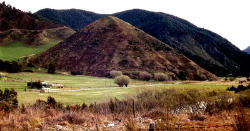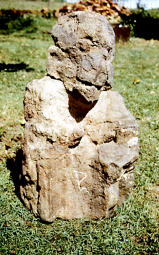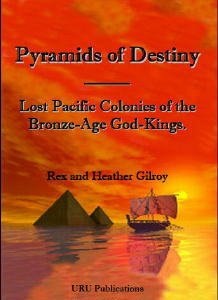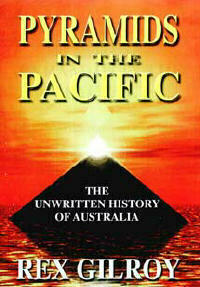
| Pyramids of Destiny – Lost Pacific Colonies of the Bronze-Age God-Kings |
 |
The “Gympie Ape” [Thoth] idol unearthed by Mr Dal K Berry on his Gympie property in 1966. The hieroglyph of a papyrus flower carved between the squatting legs is Thoth’s symbol as the God who invented the art of writing.
The “Gympie Pyramid” [as I named it] faced the four points of the compass. For an Egyptian pyramid it was unique, the summit having been employed for ceremonial functions. Partly buried in rubble on the summit’s eastern side we found a broken libation bowl formed from a large ironstone slab; and a large sandstone block, an altar stone, lay half buried nearby [the bowl would later be removed and the altar smashed beyond recognition by a religious fanatic].
|
Pyramids of Destiny – Lost Pacific Colonies of the Bronze-Age God-Kings
by Rex & Heather Gilroy
Copyright
© Rex Gilroy 2009
| “Australian history is almost always picturesque; indeed it is so curious and strange, that it is itself the chiefest novelty the country has to offer, and so it pushes all other novelties into second and third place. It does not read like history but like the most beautiful lies. Mark Twain: Following the Equator [1891] |
”Every truth passes through three stages before it is recognised. In the first, it is ridiculed. In the second, it is opposed. In the third, it is regarded as self evident.” Arthur Schopenhauer [1788-1860] |
Part Three.
Lost Egypto-Phoenician Colonies of Queensland’s Far North.
Chapter Eleven.
The Mysterious Gympie Pyramid.
All the removable inscribed stones found by the Gilroys on the pyramid were removed for safekeeping and research. All other inscribed stones recovered in the Gympie, Tin Can Bay and Maryborough areas now in authors possession.IT seems strange that, despite overwhelming evidence to the contrary, conservative scholars in Australia cannot bring themselves to accept that maritime peoples of the ancient world were familiar with our shores not hundreds, but thousands of years before the age of Magellan. They feel embarrassed every time some ‘impossible’ pyramids, Old World rock inscription or ther relic is found in Australia to refute their outdated arguments. Their embarrassment must be growing, not only from the vast amount of relics described in this book, but also from all the other evidence coming to light worldwide, through the activities of dedicated cultural diffusionists like the Gilroys!
New Zealand also goes ignored. This book shows how wrong they are. The fact is, there is enough evidence of ancient civilisation contacts with Australia and its island neighbours to rival, even surpass the pre-Columbian discovery and colonisation of the Americas [which of course includes the Uru migrations there from Australia/New Zealand!]. For many years before I met my wife Heather [1972] I had struggled on alone, writing newspaper articles, and sometimes doing radio interviews about Australia’s “hidden history”, trying to make Australians aware of their unknown past, of Stone-Age races which had preceded our Aborigines to this continent before the Dutch mariners or Lieutenant James Cook RN.
My lone field searches for ancient rock inscriptions were mostly unsuccessful to begin with and when I did begin discovering these, my efforts when published, were met with derision from university historians and archaeologists who did not even think it necessary to give me the decency of an unbiased examination of my finds. Yet, as I was to find in the writings of the ancients, there were many references to a Great Southern landmass located in the southernmost region of the world, often described as the “Lost Paradise” of mankind and a land of vast natural wealth.
Even here I found obstacles, from biased academics who would phone radio stations and newspaper offices, persuading gullible journalists not to interview or publish my findings, often ‘impressing’ them with a list of their degrees, and ‘exposing’ my amateur status. In those early days of my struggle the growing amount of finds being made by people around Australia, particularly of ancient Egyptian, Phoenician, Libyan, Celtic and other Bronze-Age period relics and rock inscriptions, convinced me that these peoples were more than mere casual visitors to Australia, and that the search for minerals, precious stones and other important commodities had to have been their purpose in coming here.
The emphasis in my researches thus turned from investigating scattered rock inscriptions and odd relics to the uncovering of colonies, which I rightly believed would have been established in mineral-rich regions. In 1972 I met my wife Heather and we soon became a ‘team’ intent upon searching for and uncovering evidence of colonisation of this land, by the peoples of the ancient world. Our first big breakthrough came in 1975.
Earlier in 1970, I had been sent a photograph of a strange ironstone image, by Mr Dal K. Berry of Gympie, in southeast Queensland. Mr Berry, a farmer, had been ploughing his field one day in 1966, when he unearthed the fragmented remains of what he realised to be an idol.
After cementing it together he found it to be in the form of a 72cm tall by 120cm diameter squatting ape. He also found that he had torn up sandstone blocks which had formed a base upon which the idol had stood. Dal Berry soon afterwards stored the relic away in his shed. However, after reading an article by me on ancient civilisation contacts with Queensland, he sent me the photograph in 1970.
It was not until October 1975 that, together with Heather, I was able to make the trip to Gympie. Upon inspecting the relic I realised it to be a crude depiction of Thoth, the God of Writing and Knowledge of ancient Egypt in Ape form. Carved between the squatting legs of the image was the hieroglyph of the papyrus flower – Thoth’s symbol as the God of Writing – while on the back were several weathered hieroglyphs of what we now know today to be a mixed Egypto-Phoenician script. Thoth, I knew, had been depicted as an ape prior to around 1000 BC, when he became an Ibis-headed, human-bodied deity who recorded the judgement of the dead in Amenti, the afterworld.
Gympie was first officially settled in the 1840s and 50s, during which time farmers began turning up some remarkable finds; mystery rock inscriptions, ancient tools of copper and bronze, as well as pottery of ancient Middle-East origin. It was enough for many of the inhabitants to suggest that British colonists were not the first people to settle this district. Gympie came to prominence in 1867, when James Nash scooped up some gold nuggets from a dry creek bed, quickly turning the district into Queensland’s most famous goldfield. By 1909 fifty-one companies were mining gold around the area.
The region is also rich in copper and tin, as well as jasper, agate and other gemstones. Prospectors, exploring the nearby forest-covered mountains and gullies made some startling discoveries in the years following James Nash’s gold strike. Remains of ancient open-cut gold and copper mining operations were uncovered outside Gympie and also in the Murgon district further west. Large basalt adzes were found beside quartz reefs where they had been used to pound away at the gold-bearing quartz..
At these sites were sometimes found various implements of copper and bronze, later identified as being of ancient Middle-East origin. Somewhere in these jungle-covered hills a pre-European water-race built of massive stone blocks was discovered, but the location is now lost. The number of relics, rock inscriptions and traces of extensive gold, copper and tin mining hereabouts, as well as extensive open-cut agate mining operations we discovered between Gympie and Murgon, and numerous ancient stoneworks that we began turning up in the region, convinced Heather and I that the district had once been the site of a Bronze-Age Middle East mining colony.
To assist us in our pyramid investigations, two locals, Mr Terry and Mrs Dian Kay, kindly arranged a light aircraft flight over the area for an aerial inspection, enabling us to photograph the structure from above, and to follow the former course of the harbour eastwards to Tin Can Bay.
To Read the complete Story watch out for the release in 2010 of the Gympie Pyramid Story by Rex and Heather Gilroy
Main Book Index | Mysterious Australia Homepage | URU Homepage | Australian Yowie Research Centre

